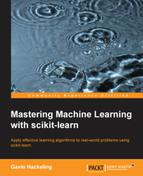Two of the most common supervised machine learning tasks are classification and regression. In classification tasks the program must learn to predict discrete values for the response variables from one or more explanatory variables. That is, the program must predict the most probable category, class, or label for new observations. Applications of classification include predicting whether a stock's price will rise or fall, or deciding if a news article belongs to the politics or leisure section. In regression problems the program must predict the value of a continuous response variable. Examples of regression problems include predicting the sales for a new product, or the salary for a job based on its description. Similar to classification, regression problems require supervised learning.
A common unsupervised learning task is to discover groups of related observations, called clusters, within the training data. This task, called clustering or cluster analysis, assigns observations to groups such that observations within groups are more similar to each other based on some similarity measure than they are to observations in other groups. Clustering is often used to explore a dataset. For example, given a collection of movie reviews, a clustering algorithm might discover sets of positive and negative reviews. The system will not be able to label the clusters as "positive" or "negative"; without supervision, it will only have knowledge that the grouped observations are similar to each other by some measure. A common application of clustering is discovering segments of customers within a market for a product. By understanding what attributes are common to particular groups of customers, marketers can decide what aspects of their campaigns need to be emphasized. Clustering is also used by Internet radio services; for example, given a collection of songs, a clustering algorithm might be able to group the songs according to their genres. Using different similarity measures, the same clustering algorithm might group the songs by their keys, or by the instruments they contain.
Dimensionality reduction is another common unsupervised learning task. Some problems may contain thousands or even millions of explanatory variables, which can be computationally costly to work with. Additionally, the program's ability to generalize may be reduced if some of the explanatory variables capture noise or are irrelevant to the underlying relationship. Dimensionality reduction is the process of discovering the explanatory variables that account for the greatest changes in the response variable. Dimensionality reduction can also be used to visualize data. It is easy to visualize a regression problem such as predicting the price of a home from its size; the size of the home can be plotted on the graph's x axis, and the price of the home can be plotted on the y axis. Similarly, it is easy to visualize the housing price regression problem when a second explanatory variable is added. The number of bathrooms in the house could be plotted on the z axis, for instance. A problem with thousands of explanatory variables, however, becomes impossible to visualize.
